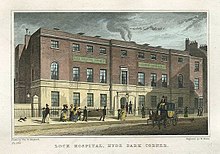Lock hospital



A lock hospital was an establishment that specialised in treating sexually transmitted diseases. They operated in Britain and its colonies and territories from the 18th century to the 20th.[1]
History
[edit]The military had a close association with a number of the hospitals. By the mid-19th century most of the larger army bases in India were home to a lock hospital.[2] There were more military than civil lock hospitals in India, due to the prevalence of venereal diseases amongst British troops.[3] In 1858 the Admiralty paid to have one opened in Portsmouth and in 1863 another in Plymouth.[4]
The earliest lock hospitals in India were established around 1797 at Berhampur, Kanpur, Danapur, and Fatehgarh. They were usually within bazaars, surrounded by a mud wall and staffed by a doctor and a female nurse. The local police were in charge of rounding up women suspected of being diseased, who could return home only after obtaining a certificate of discharge.[5]
Lock Hospital operated in Hong Kong from 1858 to 1894 to deal with venereal diseases.[citation needed]
The term "lock hospital" originates from their use as leprosariums, after the "locks", or rags, which covered the lepers' lesions.[6]
See also
[edit]- London Lock Hospital
- Birmingham Skin and Lock Hospital
- Westmoreland Lock Hospital, Dublin
- Contagious Diseases Acts
- Glasgow Lock Hospital
References
[edit]- ^ Loundes, Frederick W. (1882). Lock Hospitals and Lock Wards in General Hospitals. London: J. & A. Churchill.
- ^ Dartnell, George R. (1860). "On the prevalence and severity of syphilis in the British army and its prevention". British Medical Journal. 1 (174): 317–319. doi:10.1136/bmj.s4-1.174.317. PMC 2252720.
- ^ Sehrawat, Samiksha. "Institutions: Lock hospitals: Measures to halt venereal diseases". Medical History of British India. National Library of Scotland. Retrieved 24 October 2013.
- ^ Stark, Suzanne J. (1998). Female Tars: Women aboard ship in the age of sail. Pimlico. p. 33. ISBN 978-0-7126-6660-2.
- ^ Wald, Erica (5 May 2009). "From begums and bibis to abandoned females and idle women". The Indian Economic & Social History Review. 46 (1): 5–25. doi:10.1177/001946460804600102. S2CID 143874173.
- ^ "Lock Hospital, Hyde Park Corner". Sara Douglass, Old London Maps. 2006. Retrieved 2010-02-02.
